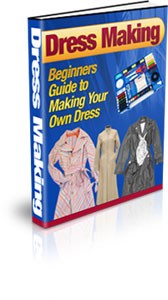 License Type: Private Label Rights
License Type: Private Label Rights  File Size: 415 KB
File Size: 415 KB File Type: ZIP
File Type: ZIP
 SKU: 2478
SKU: 2478  Shipping: Online Download
Shipping: Online Download
Ebook Sample Content Preview:
Style lines of a dress can emphasize or conceal parts of your figure. It is important that if there is something that is not pleasing to you regarding your figure that you choose the right style line in your dress pattern that will help down play that perceived fault. There are three different types of style lines – Vertical, Horizontal, and Curved. Each particular style line accents a body differently. Vertical style lines add height and make a figure look slimmer. The princess style is one example of a vertical style line. Horizontal lines tend to add an appearance of width.
These should only be used to flatter different points of ones figure. Curved seams create soft and flattering lines. Curved style lines are also often referred to as draping. Diagonal lines go from left to right when looking at a garment and long diagonal lines take the eye down in a slimming line. Use caution when using lines that appear in the weave or pattern. Straight lines are usually severe and deliver a tailored or classic look where curves and drapes appear graceful and feminine.
The basic dress garment silhouettes can be broke down into four categories – fitted, semi-fitted, slightly fitted, and loosely fitted. Fitted dress garments fit the natural curves of your body and may show off your figure. Fitted dress garments must be well cut and carefully fitted. Caution: This style may crease easy. Semi-fitted dress garments are usually fitted in the bust area with a slightly looser cut at the waist and hips. This style is more flattering for the less than perfect figure.
Slightly fitted dress garments are easy to wear and allow room for movement. They just barely follow the body outline and may be bias cut. The loosely fitted dress garment is often fitted only on the shoulders with the rest presenting full. The fullness disguises the body from the bust down.
Any garment looks best when details are not concentrated in just one area. Maintain balance by keeping an equal amount of eye appeal in two or more garment areas. Two halves may be identical so the dress has a symmetrical look. If one area has special emphasis, it may be balanced by having another point of interest elsewhere. Proportion is important when relating areas of the dress to one another and your figure. Take into consideration style lines, design details, fabric, pattern, and figure type. The scale and size of the fabric and dress must also suit the figure type.
A full mid-skirt style dress may swamp a tiny slim figure while a mini-skirt style dress is unflattering on a tall plump figure. Pleasing proportions can be achieved by planning the dress out in halves, thirds and quarters. Fro some figures, slightly uneven proportions may be more suitable. It is the over all look that is most important. To get an idea of how your dress will look on you once finished, go to dress stores and try on dress that are similar to the style you have in mind to make. Hold different fabrics up to you and see what looks best.








